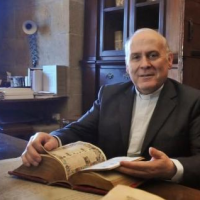Segundo L. Pérez López

Dean of the Catedral of Santiago de Compostela
Dean of the Catedral of Santiago de Compostela since 2013, Archivist-Librarian of the Cathedral of Santiago and professor of the Theological Aggregate Center of Santiago de Compostela dependent of the Pontifical University of Salamanca.
He holds a degree and a doctorate in Theology and a degree in Philosophy from the Pontifical University of Salamanca: He completed studies at the Francisco Suárez Institute of the Higher Council for Scientific Research (1979-1983) in Rome as a fellow of the Spanish Center for Ecclesiastical Studies, attached to the Church of Montserrat, taking courses in several Roman faculties and a researcher in the Vatican Secret Archives (from 1982 to 2011).
Presentation: Way of St. James and Religious Heritage yesterday and today
The initial impulse of every medieval Christian pilgrimage is provided by devotion to the holy bodies and faith in the miracle; that, in the middle centuries of the Middle Ages, will promote the way to Santiago as a privileged sacred road. Given its multifunctional nature, the way to Santiago will also be a route of trade and exchange, of political and military strategy. To this must be added, from the point of view of art history, the dissemination along the Way of St. James of certain stylistic characteristics, both from France to Spain and in the opposite direction.
The evolution of the Jacobean pilgrimage during the Modern Age until the end of the 19th century was negative, even the entire pilgrim assistance network was dismantled. The turning point of this decline must be placed in the last three decades of the nineteenth century, when explorations were made to look for the remains of the Apostle Santiago. In 1879 the precious relics were found, which would be placed in the new crypt built under the main altar of the basilica and inaugurated by celebrating an extraordinary holy year in 1885.
The new means of communication such as the railroad, the automobile and the airplane in the second half of the 20th century made traveling no longer a sacrifice, which made the city of the Apostle one of the preferred goals of a new type of "viator", in which it is very difficult to distinguish what is "pilgrim" and what is "tourist". All this, together with the work carried out by many people, such as Archbishop José Martín de Herrera, Archbishop and Cardinal Fernando Quiroga Palacios or Don Elías Valiña Sampedro, as well as the numerous Associations of Friends of the Way of St. James, allowed the reactivation of the Jacobean pilgrimage, reaching its culminating moments in the last Jubilee Years.
November














